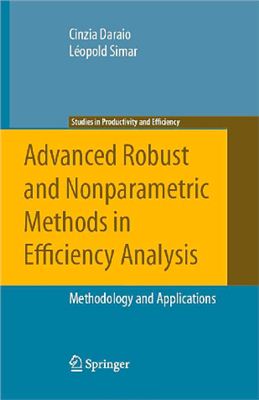Springer – 2007, 267 pages
ISBN: 0387351558
The topic of production efficiency has attracted attention since Adam Smith’s pin factory and even before. However, a rigorous analytical approach to the measurement of efficiency in production originated with the work of Koopmans (1951) and Debreu (1951), empirically applied by Farrell (1957). Farrell’s seminal work gave rise to a considerable amount of studies.
The basic idea of efficiency analysis is to make a comparison among a group of firms or branches or among Decision Making Units (DMUs), in order to evaluate how the resources (or inputs) are used to obtain (produce) the products (services or outputs). This evaluation process is based on the estimation of a benchmark frontier against which the DMUs are assessed, using DMUs’ inputs and outputs. The level of efficiency of each DMU is gauged as the distance from the estimated (‘efficient’) frontier.
In literature on efficiency analysis, the nonparametric approach has received a considerable amount of interest, both from a theoretical and an applied per- spective. This mainly because it does not require many assumptions and par- ticularly because it does not need the specification of a functional form for the frontier. Hence, the parameters of the functional form of the frontier do not have to be estimated in this approach, from which the name ‘nonparametric’ approach derives, whereas in the parametric approach, the parameters of the efficient frontier must be estimated. Data Envelopment Analysis (DEA) and Free Disposal Hull (FDH) are among the most known and applied nonparamet- ric techniques for the measurement of the efficiency in production and service activities (see e.g., Cooper, Seiford and Tone, 2000, for about 1,500 references of their applications). Nevertheless, this traditional nonparametric approach (DEA/FDH based) presents some severe limitations that are not always taken into account by researchers who apply it in empirical works. These limits should be carefully considered in order to provide a correct interpretation of the obtained results.
ISBN: 0387351558
The topic of production efficiency has attracted attention since Adam Smith’s pin factory and even before. However, a rigorous analytical approach to the measurement of efficiency in production originated with the work of Koopmans (1951) and Debreu (1951), empirically applied by Farrell (1957). Farrell’s seminal work gave rise to a considerable amount of studies.
The basic idea of efficiency analysis is to make a comparison among a group of firms or branches or among Decision Making Units (DMUs), in order to evaluate how the resources (or inputs) are used to obtain (produce) the products (services or outputs). This evaluation process is based on the estimation of a benchmark frontier against which the DMUs are assessed, using DMUs’ inputs and outputs. The level of efficiency of each DMU is gauged as the distance from the estimated (‘efficient’) frontier.
In literature on efficiency analysis, the nonparametric approach has received a considerable amount of interest, both from a theoretical and an applied per- spective. This mainly because it does not require many assumptions and par- ticularly because it does not need the specification of a functional form for the frontier. Hence, the parameters of the functional form of the frontier do not have to be estimated in this approach, from which the name ‘nonparametric’ approach derives, whereas in the parametric approach, the parameters of the efficient frontier must be estimated. Data Envelopment Analysis (DEA) and Free Disposal Hull (FDH) are among the most known and applied nonparamet- ric techniques for the measurement of the efficiency in production and service activities (see e.g., Cooper, Seiford and Tone, 2000, for about 1,500 references of their applications). Nevertheless, this traditional nonparametric approach (DEA/FDH based) presents some severe limitations that are not always taken into account by researchers who apply it in empirical works. These limits should be carefully considered in order to provide a correct interpretation of the obtained results.

